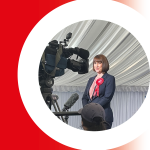
Dr Chrysi Dagoula
Assistant Professor of International Media and Communications Studies, Department of Cultural, Media and Visual Studies (CMVS), University of Nottingham. Her current research focuses on political communication and messaging in explicitly non-political cultural settings.

UK Election 2024
Section 7: News and journalism
73. Why the press still matters (Prof Steven Barnett)
74. When the Star aligned: how the press ‘voted’ (Prof Dominic Wring, Prof David Deacon)
75. Visual depictions of leaders and losers in the (still influential) print press (Prof Erik Bucy)
76. Towards more assertive impartiality? Fact-checking on BBC television news (Prof Stephen Cushion)
77. The outsize influence of the conservative press in election campaigns (Prof Dan Stevens, Prof Susan Banducci, Prof Ekaterina Kolpinskaya and Dr Laszlo Horvath)
78. GB News – not breaking any rules… (Prof Ivor Gaber)
79. Vogue’s stylish relationship to politics (Dr Chrysi Dagoula)
80. Tiptoeing around immigration has tangible consequences (Dr Maria Kyriakidou, Dr Iñaki Garcia-Blanco)
81. A Taxing Campaign (Prof David Deacon et al)
82. Not the Sun wot won it: what Murdoch’s half-hearted, last-minute endorsements mean for Labour (Dr John Jewell)
83. Is this the first podcast election? (Carl Hartley, Prof Stephen Coleman)
84. A numbers game (Prof Paul Bradshaw)
85. Election 2024 and the remarkable absence of media in a mediated spectacle (Prof Lee Edwards)
86. 2024: the great election turn-off (Prof Des Freedman)
Only once in its history has Vogue ever endorsed a leadership candidate in a general election and that was Hilary Clinton in 2016 in the US edition of Vogue. This is not to suggest that Vogue ignores political civil and social issues – it doesn’t. It has, for example, a long history of promoting women’s right, opposing racism, decrying class inequality, and addressing other forms of injustice. Indeed, the previous UK editor, Edward Enninful, was quite explicit about this. The point being that political news and discussions are generally ‘hidden’ in Vogue – they appear under ‘Viewpoints’, ‘News’, ‘Forces for Change’ and the editor’s letters. Since the announcement of the UK election, on 22nd May 2024, British Vogue posted a short piece informing its readers about the election, and a few other opinion pieces – ‘I’m 24 And A Paying Labour Party Member… But I Have No Idea How I’ll Vote In This General Election’ (26th June); ‘Why Single Mothers Like Me Matter In The Next Election’ (15th June); “This Is Not A Fringe Issue”: What’s At Stake For Disabled People In The General Election’ (10th June); What’s At Stake For Women In The 4th July General Election (23rd May) – as well as some pieces after the announcement of the election’s outcome with emphasis on women’s and climate change issues.
In its socials (‘X’, ‘Instagram’ and ‘YouTube’), however, Vogue has not been vocal at all. Its ‘X’ account acts a repository of the articles posted on Vogue’s website, whereas its Instagram and YouTube accounts are primarily focused on lifestyle, celebrity and fashion news. As for the people that are central to the election – even though none of the election candidates made it to British Vogue’s front page – Vogue has featured the Labour party leader and recently elected Prime Minister, Sir Keir Starmer in its March 2024 issue, whilst a few months earlier, in November 2023, it featured Labour’s Deputy Leader Angela Rayner. Other UK politicians have also featured in either the UK or US Vogue namely Theresa May, Dianne Abbott, Ruth Davidson, Nicola Sturgeon, and Rishi Sunak.
Following the Guardian’s lead, we might ask “why is acceptance or non-acceptance by a 130-year-old magazine important to politicians? And what is it about Vogue’s image enhancement that sets political figures off on both sides of the Atlantic?” Or to put it another way; why on realising Sturgeon had appeared not once but twice in Vogue did Liz Truss look as though “she’d swallowed a wasp”. For the record not everyone is susceptible to Vogue’s charm. Tony and Cherie Blair, and David and Samantha Cameron are said to have expressed concerns that Vogue readers were not ‘in keeping’ with the message they wish to send. Nevertheless, the desire amongst politicians to accept the invite by Vogue to appear seems to outweigh those who are squeamish. So, what’s on offer for wannabe leaders (and others)?
Straightforwardly, Vogue is a certain specific type of a didactic and cultural icon. From the start, it conceived of itself as a centre for the performance of social discernment and a space where it could endorse or condemn certain mores, norms, and behaviour. Like any icon it operates at two levels – the physical concrete real surface and the deeper more rooted meanings and narratives that the surface points to. In other words, it has a form of social force based around offering both a materialistic conception of fashion and through this it roots its cultural meaning and significance. The former – the glossy and artistic magazine, the latter – the discursive/textual and ultimately judgemental viewpoints. In other words, Vogue exemplifies social, civil and cultural distinctiveness derived from being regarded (judged) fashionable. The question is: do politicians understand being fashionable as meaning more than just being well turned out?
As Simmel noted in 1904, fashion represents a form of social equalisation that changes incessantly, and which can simultaneously unite and divide. It is a social force and like that of election, it is relentless. As the Guardian points out “the fashion magazine offers an aspect of continuity the political sphere alone cannot muster”. A magazine story and its cover may reach people outside the realm of typical messaging. It stays in circulation for a month and lies around for longer. Alongside of which, in the case of Vogue, content is presented within the confinements of a rich and well-defined symbolic framework that structures a particular action, quality or condition, in this case, whilst ‘performing politics.’ The performance of politics in Vogue is both structured by the requirement to appear to be authentically political and constrained by the evocative background that is the symbolic framework that is the deep narrative of Vogue. The two dimensions are in tension as a particular political narrative becomes contextualised by high quality visuals, adverts for hi-end goods, lifestyle commentary and observations, reports and stories concerning being fashionable, culturally significant, influential, and so on. A successful performance is dependent on the fusion of the performance with and in terms of the symbolic framework that it is set in.
